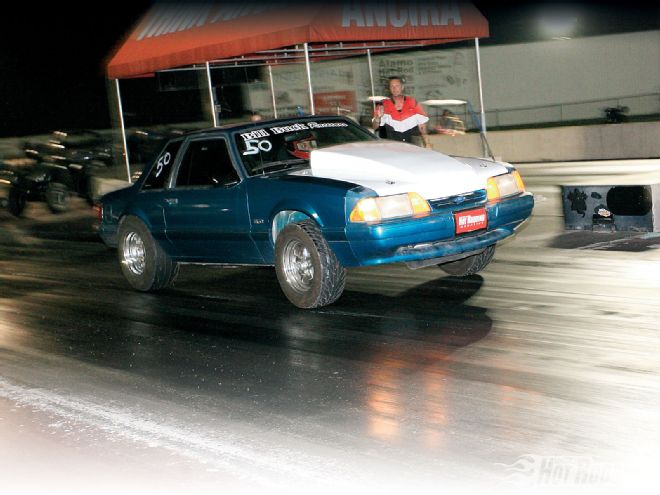
Finally, after more than a year of bolting on parts and fabricating custom doodads, Project Fox is done. The speculation ends now, and it's time to see what it will run at the track. To recap, the goal with our '93 Mustang project car has been to run 9-second e.t.'s on a blue-collar $25,000 budget. Just in case that wasn't enough of a challenge, we decided to chase down single-digits on a stock-style suspension and drag radials in a full weight, pump-gas burning, street-legal machine. Following the old hot rodder's tradition of stuffing the biggest engine possible into the smallest car you can find, a 775hp big-block Ford and a 3,000-pound Fox Mustang seemed like a logical combination. Sure, a 632ci Rat motor in a Chevy II would have been way cooler, but who's got $50,000 to spend on a project car these days? Now more than any time in recent history, cheap speed is something everyone can appreciate. And is there any enthusiast that hasn't dreamed of building a 9-second street car?
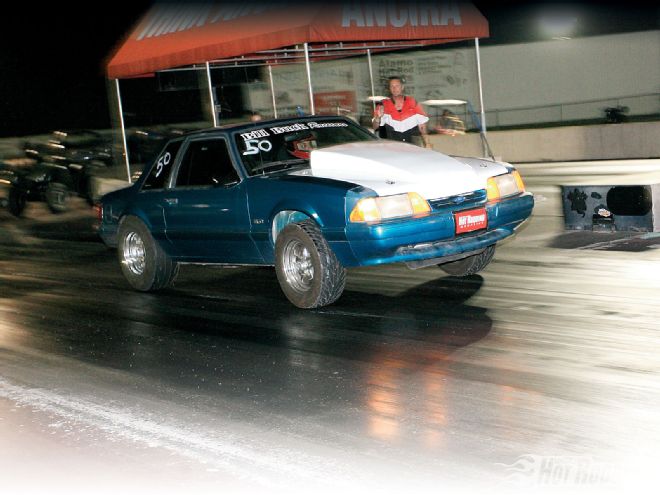
Over the course of the buildup phase, Project Fox accumulated an impressive stockpile of parts. The arsenal includes a 532ci big-block Ford built by the School of Automotive Machinists, a Phoenix TH400 trans, a Strange 8.8-inch rearend, an Anthony Jones Engineering front suspension, a Competition Engineering rear suspension, a Russell fuel system, a custom Hooker exhaust, a 10-point rollcage, Summit wheels, and Mickey Thompson tires. The good folks at Bill Buck Race Cars (www.BillBuckRaceCars.com) in Austin, Texas, did all the chassis fabrication and practically built the car. Looking at the stats, Project Fox appears to have the goods to propel it into the 9s at 140 mph. There's a big difference, however, between what a car should do in theory, and what it actually runs. No one wants phony United Nations power that only exists on paper. We want real power. You know, Oprah power.
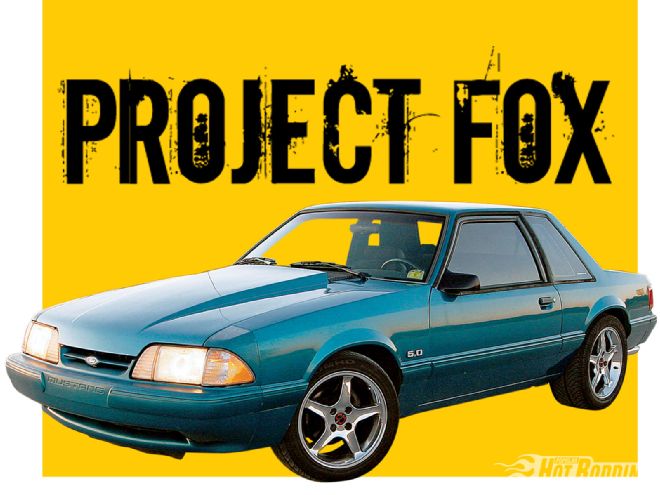
The key to achieving this sort of genuine power is optimizing a car's chassis, suspension, and tire combination to extract the most e.t. out of every last mile per hour. As any drag racer will attest, while trap speed is an excellent barometer for power-to-weight ratio and quarter-mile performance potential, all that matters at the finish line is the elapsed time. Horsepower is just half of the equation, and our biggest concern was trying to get all 775 horses to hook on 275/60-15 Mickey Thompson ET Street radials. Make no mistake that these are a sweet set of meats, providing enough stick to launch leaf-spring cars into 7s. Nevertheless, our experience with setting up drag radial cars is quite limited, and we were prepared for the steep learning curve ahead. Admittedly, our expectations entering the first round of shakedown testing were low, but after making the first pass, we were pleasantly impressed upon realizing the car would be in the 9s much sooner than anyone expected.
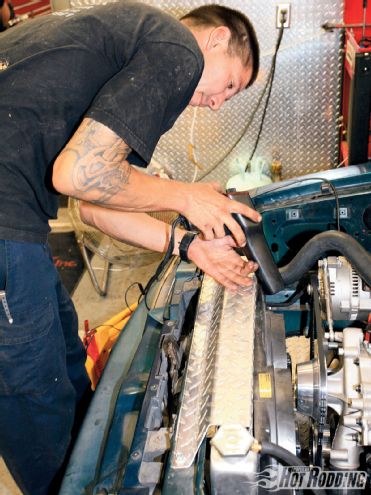 In any freshly assembled car, it's not a bad idea to run it on the chassis dyno first before hitting the track. This not only allows dialing in the ignition advance and carb jetting, but it's an excellent opportunity to check for leaks, and make sure that the car is running properly. Thanks go out to Phil Clarkson and the crew at Auto Tek in Austin, Texas, for inviting us over to use their Dynojet. Here, Clarkson sets the total timing at 28 degrees.
In any freshly assembled car, it's not a bad idea to run it on the chassis dyno first before hitting the track. This not only allows dialing in the ignition advance and carb jetting, but it's an excellent opportunity to check for leaks, and make sure that the car is running properly. Thanks go out to Phil Clarkson and the crew at Auto Tek in Austin, Texas, for inviting us over to use their Dynojet. Here, Clarkson sets the total timing at 28 degrees.
Round One
On a sweltering August evening in Texas, we headed down to San Antonio Raceway to lay down some shakedown runs. With the distributor locked out at 28 degrees of advance and 24 psi in the drag radials, we spun the hides for the first 20 feet, pedaled the throttle a hair, and ran a 10.54 at 138 mph on a 1.84-second 60-foot time. With any freshly assembled drag combination, it's not a bad idea to make some eighth-mile passes just to get a feel for the car. Thanks to our premium suspension components and the spot-on suspension setup by expert chassis tuner Bill Buck, the car drove so straight that we stayed in the throttle for the full pass. It's certainly not the smartest thing to do, but no one's ever accused us magazine guys of being smart. As no surprise, the trap speed was clearly indicative of 9-second potential, especially considering the density altitude hovered around 3,400 all night. But the 60-foot times needed some big time improvement.
During the second pass, we got a bit more aggressive with the launch, loading the converter up to 2,500 rpm. The big-block promptly blazed the tires, and the e.t. took an embarrassing hit, as the car posted an 11.45 at 134 mph. Despite the pathetic result, one important lesson we learned firsthand is that unlike a bias-ply slick, once a drag radial starts spinning it will never recover unless you lift off of the throttle. To make sure our first pass wasn't a fluke, we lined up Project Fox just before midnight for one final run. Leaving the line at just above idle and babying the gas, the Mustang ran another 10.54-at-138-mph pass on a slightly improved 1.72-second 60-foot time. Although the car was more than a half-second away from our 9-second goal, we were quite pleased with our maiden voyage to the track considering that we didn't touch the suspension, air pressure, or engine tune the entire night.
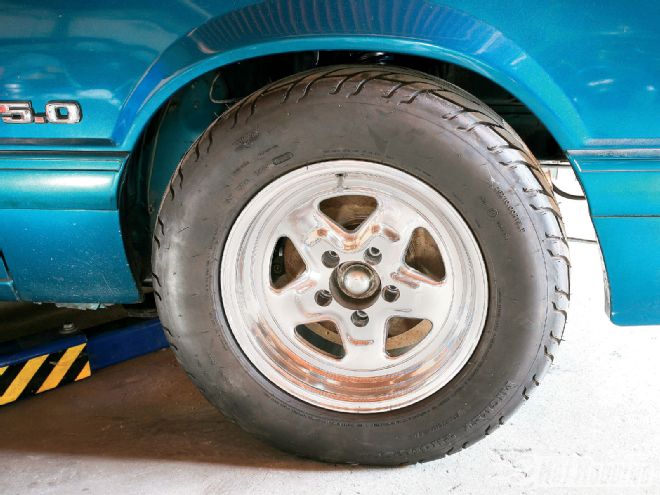 The last items we ordered before heading out to the dragstrip were a set of wheels from Summit and tires from Mickey Thompson. The Summit Fast Five wheels measure 15x7 up front, and 15x10 out back. They're wrapped in 26x10x15 Mickey Thompson Sportsman radials for the fronts, and 275/60-15 ET Street radials for the back. Yes, the fronts are awfully large, but the idea was to retain some streetability, since cruising around town with 4-inch-wide skinnies isn't any fun.
The last items we ordered before heading out to the dragstrip were a set of wheels from Summit and tires from Mickey Thompson. The Summit Fast Five wheels measure 15x7 up front, and 15x10 out back. They're wrapped in 26x10x15 Mickey Thompson Sportsman radials for the fronts, and 275/60-15 ET Street radials for the back. Yes, the fronts are awfully large, but the idea was to retain some streetability, since cruising around town with 4-inch-wide skinnies isn't any fun.
Round Two
Following the better-than-expected first round of testing, we returned to the track the following afternoon for some eighth-mile bracket racing. With the ambient air temperature pegged at 100 degrees, the track temperature conceivably much higher, and density altitude registering in at an asthmatic 4,000 feet, we prepared for greasy starting line conditions. The plan was to fiddle around with the timing curve with our programmable MSD 6AL-2 ignition box. This trick little gizmo allows dialing in a custom ignition advance curve with a laptop to account for varying track conditions. To get started, we pulled 12 degrees of advance at idle, and progressively ramped it back in by 5,000 rpm. The results were simply amazing. With no other changes from the night before, the 60-foot time dropped to 1.50 seconds and Project Fox ripped a 6.50 pass at 107.09 mph. Compared to the night before, where the car posted a best eighth-mile time of 6.94 at 107.53 mph, Project Fox picked up nearly half a second. You read right, a few simple keystrokes on the laptop to the MSD program netted nearly a half-second improvement in the eighth-mile. This is literally Pro Stock technology for the street, and the proof is in the timeslips. For a drag radial car like ours, the programmable MSD box is the most powerful tuning tool you can ask for.
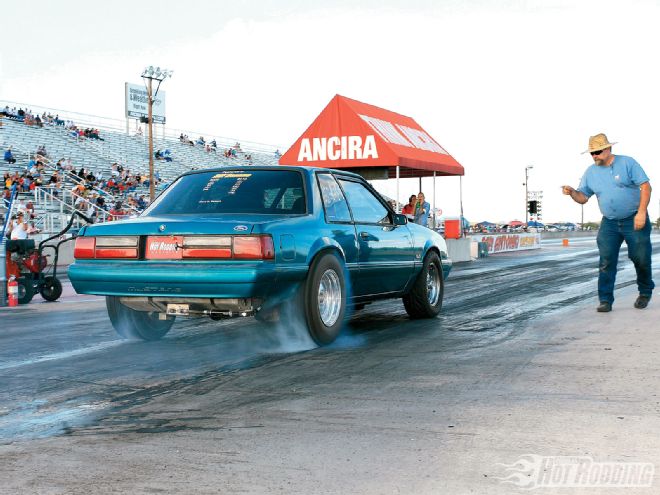 For the initial burnout on a fresh set of tires, Mickey Thompson recommends a slightly longer than usual burnout. Otherwise, the burnout procedure on drag radials isn't much different from slicks. Spinning them until you see a nice puff of smoke billowing from the wheelwells is all that's needed. Prolonged burnouts merely overheat the tires and accelerate wear.
For the initial burnout on a fresh set of tires, Mickey Thompson recommends a slightly longer than usual burnout. Otherwise, the burnout procedure on drag radials isn't much different from slicks. Spinning them until you see a nice puff of smoke billowing from the wheelwells is all that's needed. Prolonged burnouts merely overheat the tires and accelerate wear.
Depending on whom you ask, for a car that pulls the second half of the track as hard as Project Fox, a 6.50-second eighth-mile e.t. is awfully close to a 9-second quarter-mile pass. The problem was that we entered the car in a 7.00 index class, so we actually had to slow the car down. Nonetheless, it still gave us an opportunity to work on the 60-foot times, and Project Fox posted consistent short times in the 1.50 to 1.57 range all day long. Through some skillful sandbagging, we managed to make it to the finals, eventually finishing as the runner-up and taking home $200. That's not bad for a day's work.
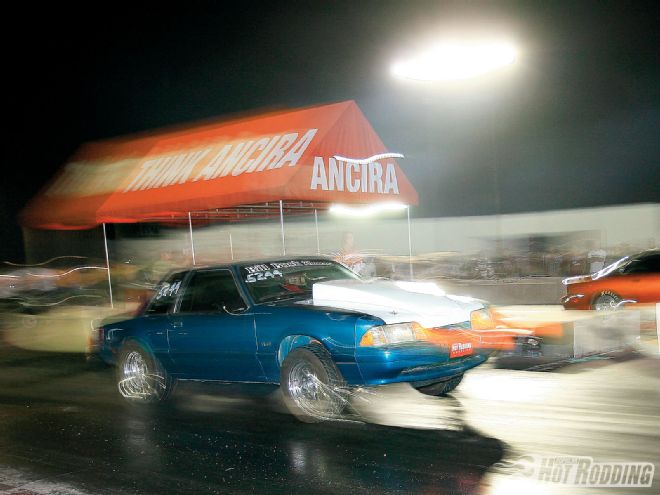 While 1.50-second 60-foot times look extremely mediocre on paper, they're actually enough to pull the front tires just a hair. A staple of any properly dialed-in drag car chassis is a rear suspension that separates from the body at launch. Thanks to Bill Buck, Project Fox does just that.
While 1.50-second 60-foot times look extremely mediocre on paper, they're actually enough to pull the front tires just a hair. A staple of any properly dialed-in drag car chassis is a rear suspension that separates from the body at launch. Thanks to Bill Buck, Project Fox does just that.
Round Three
A September evening in Texas isn't much better than an August evening in Texas. It's still damn hot and humid. Nevertheless, after waiting out several weeks' worth of tropical storms, we headed back to San Antonio Raceway with 9s on the agenda. This time out we left the same ignition curve in the motor as from the prior outing, but aired the tires down to 20 psi. Experienced drag radial experts tell us that they work best at 14-16 psi, but we wanted to hold off on dropping pressure further until we actually experienced traction problems. On the first pass, the car dead-hooked and ran a 10.34 at 136.82 mph. The unexpected increase in traction yielded a lazier launch, reflected in the car's 1.67-second 60-foot time. In the pits, we addressed the situation by dialing in a more aggressive timing curve that cut back ignition advance by 10 degrees at idle, and ramped it back in by 4,000 rpm. The changes proved effective; the 60-foot times improved to 1.57 seconds, dropping e.t. slightly to 10.31 at 135.46 mph. The troubling part of the second pass, however, was that trap speed mysteriously dropped by almost 1.5 mph from the prior run, and nearly 2.5 mph from the 138 mph Project Fox posted its first night out. This was despite the fact that the density altitude was slightly better at 3,100 feet. Had the car pulled the second-half of the track as hard as it did in the past, we figure the e.t. would have been closer to 10.20s.
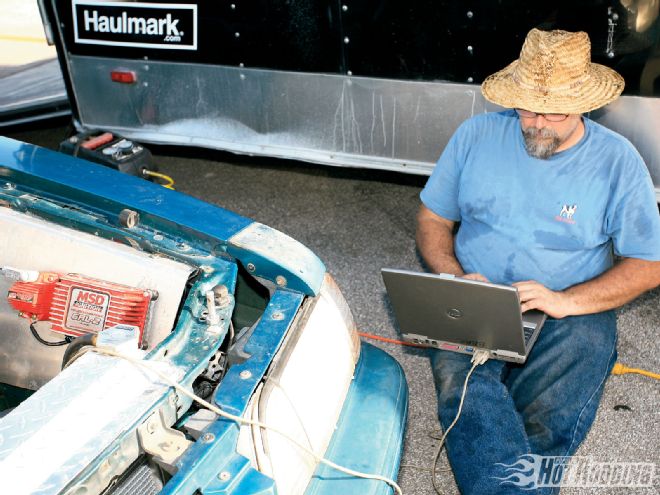 Any street/strip machine that has traction issues needs a programmable MSD 6AL-2 ignition box. They allow for the programmability of an EFI engine with the simplicity of a carb. The MSD's adjustable timing arrangement is the same technology that's been used in NHRA Pro Stock and small-tire Outlaw drag racers for years. Now it's available in MSD's street series ignition boxes for $350.
Any street/strip machine that has traction issues needs a programmable MSD 6AL-2 ignition box. They allow for the programmability of an EFI engine with the simplicity of a carb. The MSD's adjustable timing arrangement is the same technology that's been used in NHRA Pro Stock and small-tire Outlaw drag racers for years. Now it's available in MSD's street series ignition boxes for $350.
Unfortunately, the slower trap speed was just a prelude of things to come. On the trip down the return road, we noticed a loud header leak. Worse yet, the indistinguishable clatter of torque converter bolts that had rattled loose signaled a premature end to our test session. On one hand, we were extremely disappointed that we didn't leave the track with a 9-second timeslip. On the other hand, we're optimistic about breaking into the single-digits very soon, as Project Fox is far from being sorted out. With the tires hooking as hard as they did, we know we can get much more aggressive with the timing curve the next time out. Likewise, fall has finally arrived in Texas, and the cooler, drier air will only help our cause. Another issue is that Project Fox's 3.90:1 ring-and-pinion set is a wee bit too short. The 532ci big-block peaks at 6,500 rpm, but the car is turning 7,500 rpm by the time it crosses the finish line. This is compounded by a torque converter that's flashing too high at 5,500 rpm. With all the variables involved in setting up a car like Project Fox, Greg Ducato at Phoenix Transmissions got the stall speed pretty close to ideal right out of the gate. Even so, we figure tightening up the stall to 4,500 to 5,000 rpm will better suit Project Fox's powerband. Trying to foot-brake nearly 700 lb-ft of torque with the stock brakes is a huge challenge as well, so there very well could be a transbrake in our future.
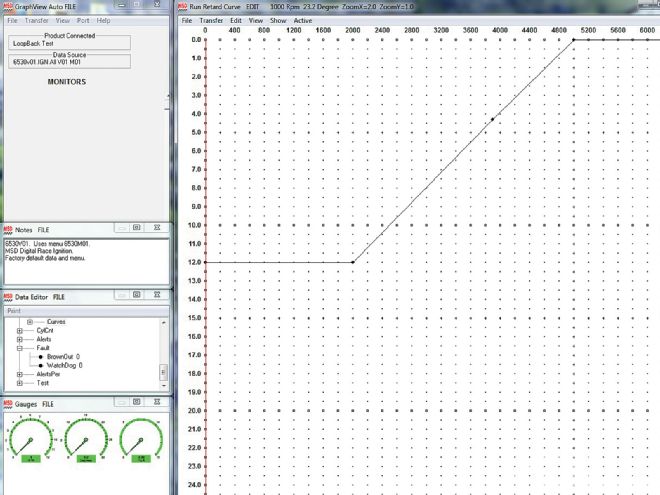 The software interface included with the programmable 6AL-2 is remarkably easy to use. Timing can be adjusted in 100-rpm increments by simply dragging plot points on the graph. Timing retard is on the Y-axis, while rpm is on the X-axis. All the end user has to do is place the data plots based on the amount of timing retard desired. The 6AL-2 also features boost retard functions, three different rev limiters, and a nitrous activation wire.
The software interface included with the programmable 6AL-2 is remarkably easy to use. Timing can be adjusted in 100-rpm increments by simply dragging plot points on the graph. Timing retard is on the Y-axis, while rpm is on the X-axis. All the end user has to do is place the data plots based on the amount of timing retard desired. The 6AL-2 also features boost retard functions, three different rev limiters, and a nitrous activation wire.
Ultimately, Project Fox isn't running as well as we'd like right now, and there are several issues that need to be addressed. That said, we're hell-bent on getting the car into the 9s as it sits right now before re-gearing it, tightening up the converter, and possibly hitting it with a 'brake. We figure knocking another tenth off the 60-foot and some better air is all it will take to get Project Fox into the single-digits while sticking to our budget of $25,000. That's a lot of coulda woulda shouldas, so we'll spare you the ricer excuses and report back once Project Fox runs a number. Right now, Project Fox has somewhere between United Nations power and Oprah power, and that's just not good enough. After getting the car into the single-digits, we plan on tinkering with some easy weight loss mods to see how deep into the 9s we can run. Then maybe we'll spray it and shoot for 8s.
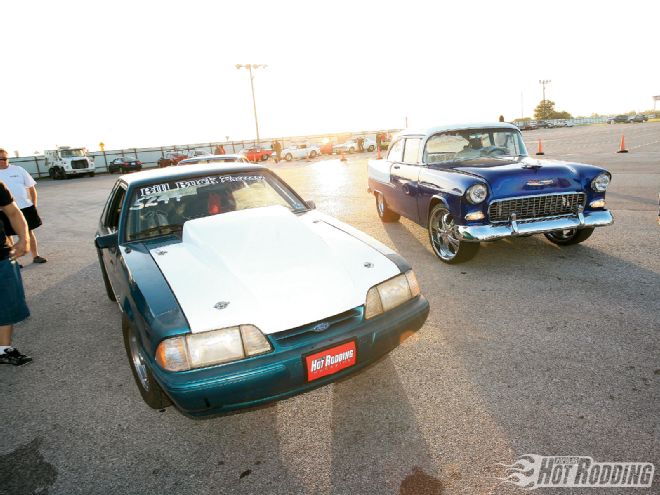 Based on the reaction from the locals at the track, witnessing a full-weight, naturally aspirated, pump-gas street car running deep-10s isn't something you see everyday. In our opinion, that's not good enough, and rest assured we'll be pounding on Project Fox hard until we get it into the 9s.
WHERE THE MONEY WENT
ITEM:
PN:
COST:
Summit 15x7 wheels (2)
521-5765PS
$210
Summit 15x10 wheels (2)
521-5166PS25
$270
Mickey Thompson Sportsman radials (2)
6027
$208
Mickey Thompson drag radials (2)
3754R
$382
Total:
$1,070
THE FINAL TALLY
ITEM:
PHR ISSUE:
PRICE:
'93 notchback Mustang
November 2009
$3,000
Sold old wheels, tires, engine, trans
N/A
-$1,000
532 big-block Ford
June 2009
$9,644
Phoenix TH400 trans
September 2009
$1,645
Strange 8.8 rearend
October 2009
$1,759
Comp Engineering rear suspension
November 2009
$1,708
AJE front suspension
December 2009
$1,679
Bill Buck custom 10-point 'cage
January 2010
$2,000
Engine and trans install
March 2010
$690
Russell fuel system
April 2010
$804
Cooling system
May 2010
$305
Strange Driveshaft
June 2010
$498
Custom exhaust
August 2010
$291
Interior rehab
September 2010
$1,545
Wheels and tires
January 2010
$1,070
Total:
$25,638
Based on the reaction from the locals at the track, witnessing a full-weight, naturally aspirated, pump-gas street car running deep-10s isn't something you see everyday. In our opinion, that's not good enough, and rest assured we'll be pounding on Project Fox hard until we get it into the 9s.
WHERE THE MONEY WENT
ITEM:
PN:
COST:
Summit 15x7 wheels (2)
521-5765PS
$210
Summit 15x10 wheels (2)
521-5166PS25
$270
Mickey Thompson Sportsman radials (2)
6027
$208
Mickey Thompson drag radials (2)
3754R
$382
Total:
$1,070
THE FINAL TALLY
ITEM:
PHR ISSUE:
PRICE:
'93 notchback Mustang
November 2009
$3,000
Sold old wheels, tires, engine, trans
N/A
-$1,000
532 big-block Ford
June 2009
$9,644
Phoenix TH400 trans
September 2009
$1,645
Strange 8.8 rearend
October 2009
$1,759
Comp Engineering rear suspension
November 2009
$1,708
AJE front suspension
December 2009
$1,679
Bill Buck custom 10-point 'cage
January 2010
$2,000
Engine and trans install
March 2010
$690
Russell fuel system
April 2010
$804
Cooling system
May 2010
$305
Strange Driveshaft
June 2010
$498
Custom exhaust
August 2010
$291
Interior rehab
September 2010
$1,545
Wheels and tires
January 2010
$1,070
Total:
$25,638